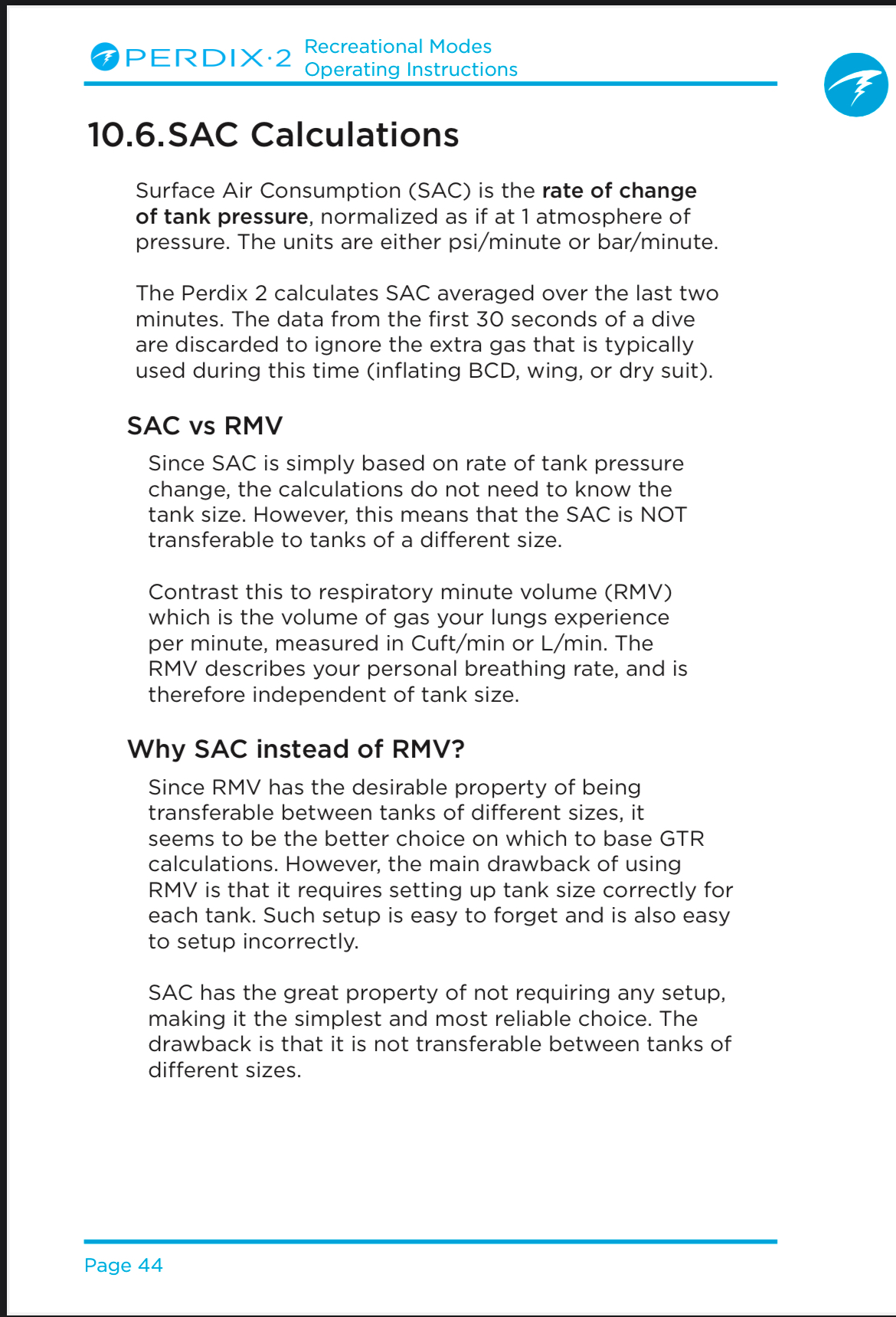Definitions...
 SAC - Surface Air Consumption - Seems self explanitory but no. As one example, there is a 200 post argument on ScubaBoard about SAC and RMV..and that is just one forum post. In a basic form, it is the amount of air pressure you consume at the surface per minute using a specific size tank. Often incorrectly quoted as a particular number without the pressure units or the size of tank like "my SAC is 33" or "my SAC is .7". In the diving areas that use PSI it is assumed to be psi/min at the surface with an Aluminum 80 tank. Given SAC is used in math calculations, that is a signficant number of assumptions to take into account.
SAC - Surface Air Consumption - Seems self explanitory but no. As one example, there is a 200 post argument on ScubaBoard about SAC and RMV..and that is just one forum post. In a basic form, it is the amount of air pressure you consume at the surface per minute using a specific size tank. Often incorrectly quoted as a particular number without the pressure units or the size of tank like "my SAC is 33" or "my SAC is .7". In the diving areas that use PSI it is assumed to be psi/min at the surface with an Aluminum 80 tank. Given SAC is used in math calculations, that is a signficant number of assumptions to take into account. SAC is psi/min/ata and is cylinder dependent
RMV - Respitory Minute Volume - Sorta self explanitory and not widely known in the diving community. When some individuals, including instructors, mention a value that is technically RMV...they called it SAC. There are even dive computers that display SAC when it's actually RMV! It is the volume of air consumed at the surface irrespective of tank size. In the diving areas that use feet it is assumed to be cubic feet per minute. Given the number does not care about tank size, it is better for use in math equations so conversion calculations do not have to occur when using different tanks.
RMV is cuft/min/ata and is cylinder independent
SCR - Surface Consumption Rate - It's the same thing as RMV but mostly used by GUE trained divers...yeah...confusing huh? For the rest of this page we will use RMV to mean both RMV and SCR.
Tank Factor - In the Imperial world, the tank factor is the relationship between cubic feet and PSI. You can calculate a Tank Factor for any given tank by taking the Volume and dividing by the Pressure, which gives you the "Baseline" and then multiplying by 100 to give you the Tank Factor. An Aluminum 80 has a volume of 77.4 cuft and a working pressure of 3000 PSI. Which is a baseline of 0.026 and a Tank Factor of 2.58. Which means an AL80 has 2.58 cuft per 100psi. Most calculations in scuba do not need to be this precise and so many people just use 80 as the volume for an Aluminium 80 (instead of 77.4) so the calculation is easier to do in their head and the Tank Factor turns out to be 2.66...but you can make that even easier on the math and just call it 2.5. Not precisely accurate...but good enough. You can also find the Tank Factor for various tanks online, you don't need to work it out yourself if you don't want to.
Assumptions...
....just use RMV to mean cuft/min and SAC for psi/min. And if someone says their [thing] is a number greater than 10..assume it's SAC. And if it's less than 10 (probably less than 1)..assume it's RMV.How to calculate SAC...if you must
Quick and dirty method([starting PSI] - [ending PSI]) / [dive time in minutes] / [average depth in atm] = SAC
(3000psi - 500psi) / 50min / 1.7atm = ~29 psi per minute for whatever tank size you used
To use SAC on the fly in the future...you have to know the Tank Factors...and nobody wants to be carrying a conversion table around or doing maths in their head.
The way you are "supposed" to do it
Dive to a specific depth and stay at that depth for a specific period of time and swim around at that depth at a normal pace. This gives you a more accurate SAC. However, if you want to see improvement (or not) trends over time, the quick and dirty method is better as you can do it for every dive and sacrifice a little precision.
How to calculate RMV...and make the world a better place
Quick and dirty method[starting PSI] - [ending PSI] * [Tank Factor / 100] = cubic feet consumed
[cubic feet consumed] / [dive time in minutes] / [average depth in atm] = RMV
3000 - 500 * (2.5 / 100) = 62.5 cuft consumed
(62.5cuft / 50min) / 1.7atm = 0.75 RMV
You have now created a universal number that doesn't require you to specify what size tank when talking to other people or when doing maths in the future.
Converting from SAC to RMV
RMV = SAC x (Tank Size / Pressure)Using the examples above that would be roughly:
0.75 = ~29 psi/min x (80 cuft / 3000 psi)
